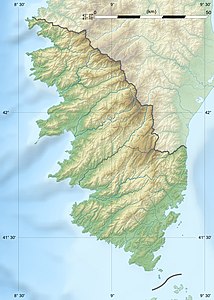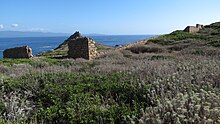Grande Sanguinaire
| Grande Sanguinaire | ||
|---|---|---|
| Grand Sanguinaire, view from the north | ||
| Waters | Mediterranean Sea | |
| Archipelago | Îles Sanguinaires | |
| Geographical location | 41 ° 52 '39 " N , 8 ° 35' 36" E | |
|
|
||
| length | 1.3 km | |
| width | 500 m | |
| surface | 32 ha | |
| Highest elevation | 82 m | |
| Residents | uninhabited | |
| View from the southeast | ||
Grande Sanguinaire , also Mezu Mare , is an uninhabited island in the Mediterranean Sea that belongs to France .
location
It is located about 1.6 kilometers off the west coast of Corsica and belongs to the area of the city of Ajaccio . Grande Sanguinaire consists of red porphyry rock and is the largest island in the Îles Sanguinaires archipelago . It marks the northern edge of the Gulf of Ajaccio . The island has an area of 32 hectares and extends from southwest to northeast over about 1.3 kilometers with a width of up to about 500 meters. The maximum height is 82 meters. The small island of Îlot de Cala d'Alga is just a few meters from the northeast tip of the island . Grand Sanguinaire is designated as a nature reserve.
There is a historic watchtower and the lighthouse Phare des Îles Sanguinaires on the island . There is a boat launch in the southeast of the island, from which a paved path leads to the lighthouse.
history
The island was owned by the Ligurian family Ponte, who grew fruit trees and vines in the 16th century. The watchtower, which is still preserved today, is first shown on a map from 1770. A quarantine hospital was set up on the island in 1802 on the orders of Napoleon Bonaparte . Seafarers initially had to live in quarantine there until they were allowed to enter Corsica. After 1816 the importance of the hospital declined. In 1847 a new hospital was built in Ajaccio. The remains of a wall forming a pentagon near the jetty on Grande Sanguinaire go back to the hospital.
In 1844 the lighthouse was put into operation after four years of construction. It was built on the highest point of the island on the site of a Genoese tower Sanguinare di Fuori built in 1590 . In 1985 the lighthouse was switched to automatic operation.
In the 19th century the French poet Alphonse Daudet stayed on the island for a while, who processed this in his work Letters from my Mill . In 1997 the director Laurent Cantet shot the film Voluntarily banished on the island .
Flora and fauna
Grand Sanguinaire is home to around 150 species of animals and plants, including birds such as the Mediterranean seagull and shearwater . Plants include dragon's mouth carrion flower , dye red , stinging bindweed and foul-smelling iris .




